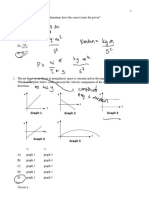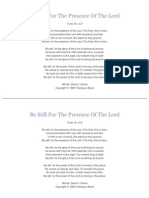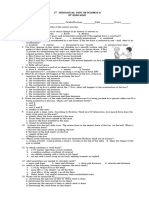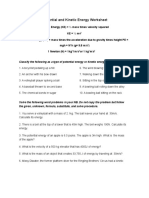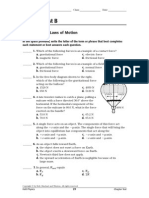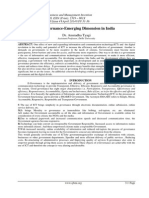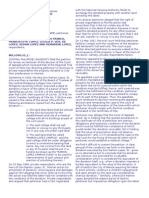Physics Unit 2 Practice Test Newton3
Physics Unit 2 Practice Test Newton3
Uploaded by
Alejandro BonCopyright:
Available Formats
Physics Unit 2 Practice Test Newton3
Physics Unit 2 Practice Test Newton3
Uploaded by
Alejandro BonCopyright
Available Formats
Share this document
Did you find this document useful?
Is this content inappropriate?
Copyright:
Available Formats
Physics Unit 2 Practice Test Newton3
Physics Unit 2 Practice Test Newton3
Uploaded by
Alejandro BonCopyright:
Available Formats
Unit 2 Practice Test: Newton's Laws
Name:_________________________
Multiple Choice Identify the letter of the choice that best completes the statement or answers the question. ____ 1. Which of the following is the cause of an acceleration or a change in an objects motion? a. speed c. force b. inertia d. velocity 2. What causes a moving object to change direction? a. acceleration c. inertia b. velocity d. force 3. Which of the following forces arises from direct physical contact between two objects? a. gravitational force c. contact force b. fundamental force d. field force 4. Which of the following forces exists between objects even in the absence of direct physical contact? a. frictional force c. contact force b. fundamental force d. field force 5. Which of the following forces is an example of a contact force? a. gravitational force c. electric force b. magnetic force d. frictional force 6. Which of the following forces is an example of a field force? a. gravitational force c. normal force b. frictional force d. tension 7. A free-body diagram of a ball in free fall in the presence of air resistance would show a. a downward arrow to represent the force of air resistance. b. only a downward arrow to represent the force of gravity. c. a downward arrow to represent the force of gravity and an upward arrow to represent the force of air resistance. d. an upward arrow to represent the force of gravity and a downward arrow to represent the force of air resistance.
____
____
____
____
____
____
____
____
8. In the free-body diagram shown above, which of the following is the gravitational force acting on the balloon? a. 1520 N c. 4050 N b. 950 N d. 5120 N 9. Which of the following is the tendency of an object to maintain its state of motion? a. acceleration c. force b. inertia d. velocity
____ 10. A late traveler rushes to catch a plane, pulling a suitcase with a force directed 30.0 above the horizontal. If the horizontal component of the force on the suitcase is 60.6 N, what is the force exerted on the handle? a. 53.0 N c. 65.2 N b. 70.0 N d. 95.6 N ____ 11. A car goes forward along a level road at constant velocity. The additional force needed to bring the car into equilibrium is a. greater than the normal force times the coefficient of static friction. b. equal to the normal force times the coefficient of static friction. c. the normal force times the coefficient of kinetic friction. d. zero. ____ 12. A sled is pulled at a constant velocity across a horizontal snow surface. If a force of 8.0 101 N is being applied to the sled rope at an angle of 53 to the ground, what is the force of friction between the sled and the snow? a. 83 N c. 48 N b. 64 N d. 42 N ____ 13. If a nonzero net force is acting on an object, then the object is definitely a. at rest. c. being accelerated. b. moving with a constant velocity. d. losing mass. ____ 14. A wagon with a weight of 300.0 N is accelerated across a level surface at 0.5 m/s2. What net force acts on the wagon? (g = 9.81 m/s2) a. 9.0 N c. 150 N b. 15 N d. 610 N ____ 15. A small force acting on a human-sized object causes a. a small acceleration. c. a large acceleration. b. no acceleration. d. equilibrium. ____ 16. According to Newtons second law, when the same force is applied to two objects of different masses, a. the object with greater mass will experience a great acceleration and the object with less mass will experience an even greater acceleration. b. the object with greater mass will experience a smaller acceleration and the object with less mass will experience a greater acceleration. c. the object with greater mass will experience a greater acceleration and the object with less mass will experience a smaller acceleration. d. the object with greater mass will experience a small acceleration and the object with less mass will experience an even smaller acceleration. ____ 17. Two perpendicular forces, one of 45.0 N directed upward and the second of 60.0 N directed to the right, act simultaneously on an object with a mass of 35.0 kg. What is the magnitude of the resultant acceleration of the object? a. 2.14 m/s2 b. 3.00 m/s2 c. 5.25 m/s2 d. 1.41 m/s2 ____ 18. An airplane with a mass of 1.2 104 kg tows a glider with a mass of 0.60 104 kg. If the airplane propellers provide a net forward thrust of 3.6 104 N, what is the acceleration of the glider? a. 2.0 m/s2 c. 6.0 m/s2 2 b. 3.0 m/s d. 9.8 m/s2 ____ 19. A hammer drives a nail into a piece of wood. Identify an action-reaction pair, and compare the forces exerted by each object. a. The nail exerts a force on the hammer; the hammer exerts a force on the wood. b. The hammer exerts a force on the nail; the wood exerts a force on the nail. c. The hammer exerts a force on the nail; the nail exerts a force on the hammer. d. The hammer exerts a force on the nail; the hammer exerts a force on the wood.
____ 20. The statement by Newton that for every action there is an equal but opposite reaction is which of his laws of motion? a. first c. third b. second d. fourth ____ 21. Which are simultaneous equal but opposite forces resulting from the interaction of two objects? a. net external forces c. gravitational forces b. field forces d. action-reaction pairs ____ 22. A measure of the quantity of matter is a. density. c. force. b. weight. d. mass. ____ 23. A change in the force of gravity acting on an object will affect the objects a. mass. c. weight. b. frictional force. d. inertia. ____ 24. There are six books in a stack, and each book weighs 5 N. The coefficient of friction between the books is 0.2. With what horizontal force must one push to start sliding the top five books off the bottom one? a. 1 N c. 3 N b. 5 N d. 7 N ____ 25. An ice skater moving at 10.0 m/s coasts to a halt in 1.0 102 m on a smooth ice surface. What is the coefficient of friction between the ice and the skates? a. 0.025 c. 0.102 b. 0.051 d. 0.205 Short Answer 26. Construct a free-body diagram of a car being towed.
27. What happens to an object in motion when it experiences a nonzero net external force?
28. What is the natural tendency of an object that is in motion?
____________________________
29. Describe the forces acting on a car as it moves along a level highway in still air at a constant speed.
30. A block of wood supported by two concrete blocks is chopped in half by a karate instructor. Identify an action-reaction pair, and compare the forces exerted by each object.
31. When a horse pulls on a cart, the cart pulls on the horse with an equal but opposite force. How is the horse able to pull the cart?
32. When a car is moving, what happens to the velocity and acceleration of the car if the air resistance becomes equal to the force acting in the opposite direction?
Unit 2 Practice Test: Newton's Laws Answer Section
MULTIPLE CHOICE
1. 2. 3. 4. 5. 6. 7. 8. 9. 10. 11. 12. 13.
C D C D D A C C B B D C C
14. 15. 16. 17. 18. 19. 20. 21. 22. 23. 24. 25.
B A B A A C C D D C B B
SHORT ANSWER
26. 27. The object experiences a change in motion. 28. The natural condition for a moving object is to remain in motion once it has been set in motion. 29. Gravity exerts a downward force on the car that is balanced by the normal force of the road acting upward on the car. The car's forward motion is opposed by the friction between the road and the tires and by the resistance of the air. The sum of these opposing forces is balanced by an equal and opposite force exerted by the engine and applied to the tires, where the road exerts a reaction force that is directed forward. 30. The hand exerts a force on the wood, and the wood exerts an equal force on the hand. 31. The horse and the cart are not necessarily at equilibrium. The forces in the action-reaction pair are each applied to different objects. 32. The acceleration is then zero, and the car moves at a constant speed.
You might also like
- Practice Exam 2Document13 pagesPractice Exam 2gnotzmNo ratings yet
- Securities AdministrationDocument120 pagesSecurities AdministrationHmani EmnaNo ratings yet
- Chapter Test B: Two-Dimensional Motion and VectorsDocument7 pagesChapter Test B: Two-Dimensional Motion and VectorsAref DahabrahNo ratings yet
- Wolfson Eup3 ch09 Test BankDocument15 pagesWolfson Eup3 ch09 Test Bank陳禹誌No ratings yet
- Physics MC Forces Newtons LawsDocument31 pagesPhysics MC Forces Newtons LawsT W100% (1)
- Motion - Grade 9Document44 pagesMotion - Grade 9Niranjan KanvindeNo ratings yet
- Unit 4 Lesson Plans - Newtons Laws of MotionDocument4 pagesUnit 4 Lesson Plans - Newtons Laws of Motionsiti nurhasanahNo ratings yet
- Tower Weight DetailsDocument5 pagesTower Weight DetailsSourav Satapathy100% (1)
- Throne Room Events - Pathfinder: Kingmaker WikiDocument18 pagesThrone Room Events - Pathfinder: Kingmaker WikiBeki LokaNo ratings yet
- Be Still For The Presence of The LordDocument1 pageBe Still For The Presence of The LordChindu Mathew Kuruvilla50% (2)
- Test Review Newtons LawsDocument3 pagesTest Review Newtons Lawsandy mcevoyNo ratings yet
- Energy, Work, Power and Momentum ReviewDocument7 pagesEnergy, Work, Power and Momentum ReviewJACOB SANCHEZNo ratings yet
- Chapter Test FORCEDocument5 pagesChapter Test FORCEArnulfo Villasfer SantiagoNo ratings yet
- Multiple Choice: Identify The Choice That Best Completes The Statement or Answers The QuestionDocument8 pagesMultiple Choice: Identify The Choice That Best Completes The Statement or Answers The QuestionMona Mohamed SafwatNo ratings yet
- Physics Chapter 3 Practice TestDocument2 pagesPhysics Chapter 3 Practice TestVanessa Bugarin MananzanNo ratings yet
- Science8 Pretest 1st QuarterDocument2 pagesScience8 Pretest 1st QuarterRAYMUND RODILLONo ratings yet
- 4th Grading - Grade 9 Basic PhysicsDocument3 pages4th Grading - Grade 9 Basic PhysicsDiane Marr N. Dencio100% (1)
- Chapter 4 Force and Newtons Laws of MotionDocument23 pagesChapter 4 Force and Newtons Laws of MotionQassem MohaidatNo ratings yet
- Physics Exam Multiple Choice QuestionsDocument5 pagesPhysics Exam Multiple Choice QuestionsNader HijaziNo ratings yet
- 50items EXAM. TUPAG E.Document5 pages50items EXAM. TUPAG E.Erika Mae Tupag0% (1)
- Physics Final Exam Study Guide AnswersDocument3 pagesPhysics Final Exam Study Guide Answersapi-354691443No ratings yet
- Newton's Laws of Motion Challenge: Name: DateDocument1 pageNewton's Laws of Motion Challenge: Name: DateNubar MammadovaNo ratings yet
- CP Phys CH 2 Web RevDocument8 pagesCP Phys CH 2 Web RevMichelle MuliawidjajaNo ratings yet
- Weekly Assessment Number 1Document1 pageWeekly Assessment Number 1Marissa FontanilNo ratings yet
- Force 8Document20 pagesForce 8Liana Belle0% (1)
- Lesson 2: We Are All Made ofDocument58 pagesLesson 2: We Are All Made ofGJ BadenasNo ratings yet
- Forces in One Dimension-2Document3 pagesForces in One Dimension-2varaprasad100% (1)
- Physics 03-01 Work and The Work-Energy TheoremDocument2 pagesPhysics 03-01 Work and The Work-Energy Theoremmechanical_lecturerNo ratings yet
- Kepler Laws Review AnswersDocument2 pagesKepler Laws Review Answersgabriel UYNo ratings yet
- The Models of The UniverseDocument2 pagesThe Models of The UniverseJoseph GuerreroNo ratings yet
- Hapter: Conceptual ProblemsDocument52 pagesHapter: Conceptual ProblemsAmeen ShaikNo ratings yet
- Newtons First and Second Laws Quiz1Document4 pagesNewtons First and Second Laws Quiz1Aldous ChouNo ratings yet
- Kinetic and Potential EnergyDocument4 pagesKinetic and Potential EnergyLarie Bajares33% (3)
- Po → Pb α C → N βDocument19 pagesPo → Pb α C → N βJaypee Jael AligwayNo ratings yet
- Prelim Exam: Esas Review (3:00-4:30 PM, TTH)Document4 pagesPrelim Exam: Esas Review (3:00-4:30 PM, TTH)Jun RyNo ratings yet
- Chapter 01Document4 pagesChapter 01Michelle HsiehNo ratings yet
- Gravity Exploration Worksheet - HonorsDocument2 pagesGravity Exploration Worksheet - HonorsKlavel PajollariNo ratings yet
- Kepler Laws Review AnswersDocument2 pagesKepler Laws Review AnswersAllen Peter Uy100% (1)
- Chapter 2 Test (Newton's Laws A)Document3 pagesChapter 2 Test (Newton's Laws A)Marija CvetkovicNo ratings yet
- Net Force: Physics 11 M. Lam Name: BlockDocument2 pagesNet Force: Physics 11 M. Lam Name: Block700spymaster007No ratings yet
- 4.1 Conceptual Questions: Chapter 4 Dynamics: Newton's Laws of MotionDocument18 pages4.1 Conceptual Questions: Chapter 4 Dynamics: Newton's Laws of MotionnourNo ratings yet
- Uniform Circular MotionDocument11 pagesUniform Circular MotionAnne Margaret AlmedaNo ratings yet
- Science 8 Summative Test No.1 Name: - ScoreDocument2 pagesScience 8 Summative Test No.1 Name: - ScoreNadine PortesNo ratings yet
- 1st Periodic Test - Science 8Document2 pages1st Periodic Test - Science 8Erwin Mercado100% (1)
- Chapter 9 Static Equilibrium Elasticity and Fracture: Physics: Principle and Applications, 7e (Giancoli)Document24 pagesChapter 9 Static Equilibrium Elasticity and Fracture: Physics: Principle and Applications, 7e (Giancoli)KarissaNo ratings yet
- Work Power and EnergyDocument18 pagesWork Power and EnergySubho Bhattacharya0% (1)
- Gravitation Worksheet 1Document3 pagesGravitation Worksheet 1Sharadchandra KashettiwarNo ratings yet
- Multiple Choice Review QuestionsDocument2 pagesMultiple Choice Review QuestionsJessa Claire Cabusao100% (1)
- 8.5 Final Review Key PDFDocument4 pages8.5 Final Review Key PDFAlex VongNo ratings yet
- Cercado MidtermExam AdvancedPhySciDocument6 pagesCercado MidtermExam AdvancedPhySciJudy Ann CercadoNo ratings yet
- Momentum Mtultiple CDocument7 pagesMomentum Mtultiple CSam FordNo ratings yet
- VibDocument12 pagesVibChristelle DomingoNo ratings yet
- Pre-Lim Test QuestionaireDocument2 pagesPre-Lim Test QuestionaireJuadjie Parba100% (1)
- Projectile Motion WorksheetDocument18 pagesProjectile Motion WorksheetPrinces Paula Mendoza Balanay100% (1)
- Applications of Newtons Laws - Practice ProblemsDocument4 pagesApplications of Newtons Laws - Practice ProblemslisagolzarNo ratings yet
- Potential and Kinetic Energy WorksheetDocument2 pagesPotential and Kinetic Energy WorksheetJorge ArguelloNo ratings yet
- Ke & Pe PracticeDocument2 pagesKe & Pe PracticejjNo ratings yet
- Forces in MotionDocument5 pagesForces in MotionutheinsweNo ratings yet
- C4-Dynamics Newton's Law of MotionDocument13 pagesC4-Dynamics Newton's Law of MotionHisyammudin RoslanNo ratings yet
- Calculating Force WorksheetDocument2 pagesCalculating Force WorksheetCel GrandeNo ratings yet
- Physics Chapter 4 - Test A: Multiple ChoiceDocument4 pagesPhysics Chapter 4 - Test A: Multiple ChoiceCamdrn WrightNo ratings yet
- Practice Test CH 4Document4 pagesPractice Test CH 4Umair Nadeem100% (1)
- Gist Physcie ExamDocument3 pagesGist Physcie Examulyann ningalNo ratings yet
- Class 11th PhysicsDocument2 pagesClass 11th PhysicsBalaji NsNo ratings yet
- 1.contract Ii (Contracts of Guarantee An Analysis)Document11 pages1.contract Ii (Contracts of Guarantee An Analysis)Palak ThakrarNo ratings yet
- 10443910505Document7 pages10443910505mahmoudebrahim96745No ratings yet
- Leave Rules: Leave On Average PayDocument10 pagesLeave Rules: Leave On Average Payabhimanyutiwari1234No ratings yet
- NFPA80 SummaryDocument2 pagesNFPA80 SummaryWissam AlameddineNo ratings yet
- Well Known Trademaks Updated Newone PDFDocument7 pagesWell Known Trademaks Updated Newone PDFHarika ChakravarthyNo ratings yet
- Powers and Functions and AdministrationDocument12 pagesPowers and Functions and Administrationstudyhard442No ratings yet
- Judicial Review PDFDocument18 pagesJudicial Review PDFSaurabh YadavNo ratings yet
- Taxation Law Notes KSLU Grand Final Taxation Law Notes KSLU Grand FinalDocument83 pagesTaxation Law Notes KSLU Grand Final Taxation Law Notes KSLU Grand Final21415 DIYANo ratings yet
- MFC 8890DW-Manual ServicioDocument519 pagesMFC 8890DW-Manual Serviciodgonzalez_101No ratings yet
- Corprate Finance-Final AssignmentDocument37 pagesCorprate Finance-Final Assignmentifti_MENo ratings yet
- Shover V ShrimpDocument15 pagesShover V ShrimpYTOLeaderNo ratings yet
- UMak BarOps Pre-Week Notes - Remedial Law-Legal and Judicial Ethics and Practical ExercisesDocument93 pagesUMak BarOps Pre-Week Notes - Remedial Law-Legal and Judicial Ethics and Practical ExercisesJohn MarstonNo ratings yet
- Draft SEBI Investment Advisor RegulationsDocument51 pagesDraft SEBI Investment Advisor RegulationspbdkpkNo ratings yet
- E-Governance-Emerging Dimension in India: Dr. Anuradha TyagiDocument6 pagesE-Governance-Emerging Dimension in India: Dr. Anuradha TyagiinventionjournalsNo ratings yet
- Lec 14 - Mughal and Afghan RuleDocument17 pagesLec 14 - Mughal and Afghan Ruleshahxakir1998No ratings yet
- KS 12 Lan 1 - KS Anh 12 - 403Document4 pagesKS 12 Lan 1 - KS Anh 12 - 403Triết LêNo ratings yet
- MMC Vapor Valve Manual 2020Document14 pagesMMC Vapor Valve Manual 2020thiagoNo ratings yet
- Operation of Church OfficesDocument14 pagesOperation of Church OfficesJosue TorresNo ratings yet
- Kaplanis V JBI Inc Et Al Doc 15 Filed 23 Nov 10Document19 pagesKaplanis V JBI Inc Et Al Doc 15 Filed 23 Nov 10scion.scion100% (1)
- General Physics I: Learning Activity SheetDocument23 pagesGeneral Physics I: Learning Activity SheetHekdeg HakdogNo ratings yet
- SMS UnhappyDocument3 pagesSMS UnhappyKrithi Gugan100% (2)
- AssignmentDocument2 pagesAssignmentLinda DurbinNo ratings yet
- Huewai 4G Router HelpDocument49 pagesHuewai 4G Router HelpShrinivas DasariNo ratings yet
- Legal PhilosophyDocument14 pagesLegal PhilosophyERICKSKIE23No ratings yet
- Central Philippine University v. CA, 246 SCRA 511 (1995)Document7 pagesCentral Philippine University v. CA, 246 SCRA 511 (1995)Fides DamascoNo ratings yet
- Ethics and Professional Conducts For Civil Engineers: ASCE GuidelineDocument18 pagesEthics and Professional Conducts For Civil Engineers: ASCE Guidelinescrib2323No ratings yet
